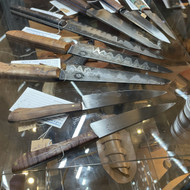Our Quest for the Best Kitchen Knife
16th Mar 2024
For the last two weeks we have been researching knives and visiting top cutlery shops in New York and Washington in search of the perfect knife for Treeboard's customers. And we found it.
After all, the whole point of a cutting board is to preserve the cutting edges of quality kitchen knives. (And we finally realized the cheap knife set given to Will by his former employer was inadequate.)
The goal: Aareliably manufactured knife, ferociously sharp but also comfortable and not too large and intimidating for Treeboard's customers, many of whom cook for their families to promote health and wellbeing. While Will has used carbon steel since his first Boy Scout knife, overall we wanted to avoid rusting and look for something stain resistant that would also hold its edge as long as possible.
In the process, we looked at the beautiful offerings of District Cutlery in Washington's Union Market and the legendary Korin in Manhattan's Tribeca. We even visited Tahoma Knives, where we saw students hammering red-hot steel and a salesman showing off one-of-a-kind handcrafted works of art. (Along the way we learned that we have to start thinking about sharpening knives in a different way—and form relationships with master sharpeners.)
We struck gold at Yanagi Knife, a small shop in Brooklyn's Chinatown that's bristling with sharpened knives, from the traditional swordlike Japanese sushi knives to Western-influenced models and even a house brand. The owner, a former Japanese restaurant chef, deals with top New York restaurant workers every day and knows what the professional demands—not just what catches the consumer's eye.
After handling a frightening array of knives, we brandished the 180 mm Misono 440 Molybdenum gyuto. Makers of all types of implements talk about the "balance" of their products, but the Misono knife actually felt balanced from first touch. And it was light! Intriguingly, the handle was rounded and comfortable, even for smaller hands.
It was love at first grasp, and the knife was so beautiful we hesitated to use it at home (Yanagi's only had two for us to purchase at the time).
Yet we eventually we tried it out on a skirt steak. You see, gyuto means "beef sword" in Japanese. Trimming the excess fat off was a breeze, and when we sliced the cooked steak the knife glided through the meat. The slicing process was done so quickly we were a little bit disappointed to put the knife down, until a rumbling stomach reminded us it was time to eat. The knife also made short work of broccoli crowns and stems, which split in half like confetti, and we chopped some fresh chives and chard from the garden.
The 180 mm gyuto is the shortest one Misono makes in Seki, Japan (a swordsmith center for centuries). It's not a machete and isn't suitable for cutting lobsters, bony meat or stubborn root vegetables. (It's too light, and you don't want to mess up the tip.) So we'll be suggesting another knife soon for those tasks. It's also not long enough for mass-producing large-dimension entrees for restaurants or large family gatherings.
In summary, it's the best multipurpose starter knife we've found yet. And having a quality blade has already transformed our kitchen. (One example: the lighter lighter strokes of the sharp blade mean fewer gouges in the beautiful cutting board underneath.)
The best best thing about it all is feeling like a fancy chef, if only for a moment.

